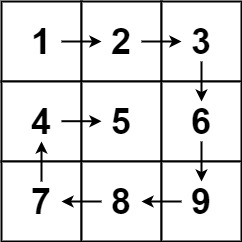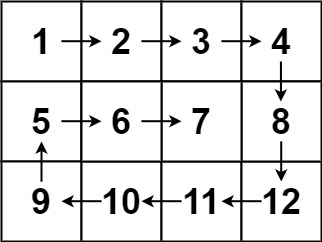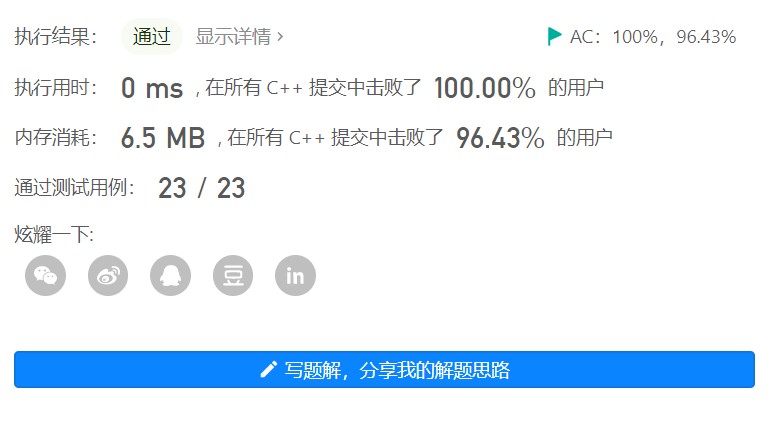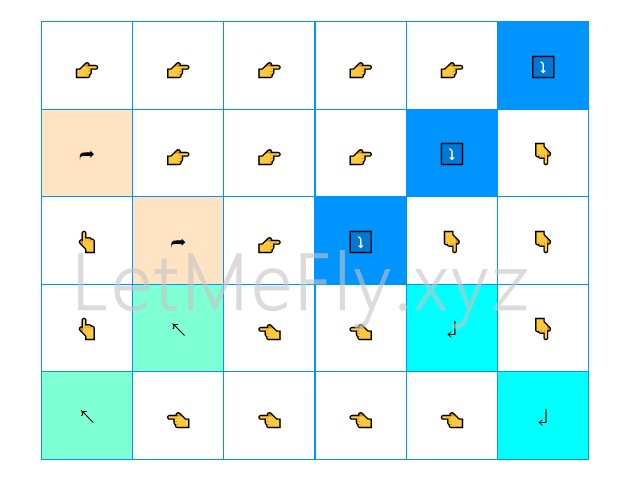LeetCode 54.螺旋矩阵 - 原地修改
Posted Tisfy
tags:
篇首语:本文由小常识网(cha138.com)小编为大家整理,主要介绍了LeetCode 54.螺旋矩阵 - 原地修改相关的知识,希望对你有一定的参考价值。
【LetMeFly】54.螺旋矩阵 - 原地修改
力扣题目链接:https://leetcode.cn/problems/spiral-matrix/
给你一个 m行 n列的矩阵 matrix,请按照 顺时针螺旋顺序 ,返回矩阵中的所有元素。
示例 1:

输入:matrix = [[1,2,3],[4,5,6],[7,8,9]]
输出:[1,2,3,6,9,8,7,4,5]
示例 2:

输入:matrix = [[1,2,3,4],[5,6,7,8],[9,10,11,12]]
输出:[1,2,3,4,8,12,11,10,9,5,6,7]
提示:
- m = = m a t r i x . l e n g t h m == matrix.length m==matrix.length
- n = = m a t r i x [ i ] . l e n g t h n == matrix[i].length n==matrix[i].length
- 1 < = m , n < = 10 1 <= m, n <= 10 1<=m,n<=10
- − 100 ≤ m a t r i x [ i ] [ j ] ≤ 100 -100 \\leq matrix[i][j] \\leq 100 −100≤matrix[i][j]≤100
思路
我们只需要从 ( 0 , 0 ) (0, 0) (0,0)开始,按题目意思模拟即可。
方法一:模拟(简单,但需要修改原数组)
先小开心一波,这次执行效率小高了一次嘻嘻

我们定义一个directions数组,来代表要遍历的方向。
const int directions[4][2] = 0, 1, 1, 0, 0, -1, -1, 0; // 分别对应:👉👇👈👆
然后还需要一个变量nowDirection,来记录当前的方向。
用变量loc来记录当前已经遍历过的元素的数量,当已遍历的数量小于总元素个数时,继续遍历。
int loc = 0; // 遍历了几个元素了
while (loc < n)
继续遍历
每次遍历时,先把当前位置的元素存入答案中(用 x x x和 y y y记录当前位置,初始值都为 0 0 0),标记当前位置为已遍历过并把 l o c + 1 loc + 1 loc+1。
因为题目中说元素的数据范围是 [ − 100 , 100 ] [-100,100] [−100,100],所以我们可以把已遍历过的元素标记为 101 101 101
ans[loc++] = matrix[x][y];
matrix[x][y] = ALREADY; // ALREADY的值可以是101
然后就看下一个位置是否未被遍历过
#define ifOK(x, y) if (x >= 0 && x < matrix.size() && y >= 0 && y < matrix[0].size() && matrix[x][y] != ALREADY) // 判断(x, y)是否OK(既在数据范围内又没被遍历过)
int nx = x + directions[nowDirection][0];
int ny = y + directions[nowDirection][1];
ifOK(nx, ny)
...
如果下一个元素可行就更新 x x x和 y y y为当前方向的下一个元素;
如果下一个元素不可行就更改遍历方向为下一个方向,并更新 x x x和 y y y为新方向的下一个元素。
nowDirection = (nowDirection + 1) % 4;
x += directions[nowDirection][0];
y += directions[nowDirection][1];
- 时间复杂度 O ( n m ) O(nm) O(nm)
- 空间复杂度 O ( 1 ) O(1) O(1),但是注意如果不允许修改原数组,则此方法将要消耗O(nm)的空间复杂度。
AC代码
C++
#define ALREADY 101
#define ifOK(x, y) if (x >= 0 && x < matrix.size() && y >= 0 && y < matrix[0].size() && matrix[x][y] != ALREADY)
const int directions[4][2] = 0, 1, 1, 0, 0, -1, -1, 0; // 👉👇👈👆
class Solution
public:
vector<int> spiralOrder(vector<vector<int>>& matrix)
int n = matrix.size() * matrix[0].size();
vector<int> ans(n);
int nowDirection = 0; // 现在的方向
int loc = 0; // 遍历了几个元素了
int x = 0, y = 0; // 当前应该遍历的位置
while (loc < n)
ans[loc++] = matrix[x][y];
matrix[x][y] = ALREADY;
int nx = x + directions[nowDirection][0];
int ny = y + directions[nowDirection][1];
ifOK(nx, ny)
x = nx, y = ny;
else
nowDirection = (nowDirection + 1) % 4;
x += directions[nowDirection][0];
y += directions[nowDirection][1];
return ans;
;
方法二:模拟(不那么好想,但不需要修改原数组)
方法一中,我们判断前进方向是否修改的方式是“看下一个点有没有走过”。因此我们把已经走过的点做了个标记。
那么,有没有什么 不看下一个点是否走过就能判断是否该转向了 的办法呢?答案当然是有的。
接下来让我们来绘制一下走向图:
以5*6的表格为例,生成html表格的Emmet代码为(在支持Emmet语法的编辑器中输入下面代码按回车即可):
center>table[style="border: 0px solid #0094ff; border-collapse: collapse; padding: 1px; table-layout: fixed; text-align: center;"]>tr[style="border: 1px solid #0094ff; height: 70px"]*5>td[style="border: 1px solid #0094ff; width: 70px"]*6
然后填入要前进的方向:
| 👉 | 👉 | 👉 | 👉 | 👉 | ⤵️ |
| ⮫ | 👉 | 👉 | 👉 | ⤵️ | 👇 |
| 👆 | ⮫ | 👉 | ⤵️ | 👇 | 👇 |
| 👆 | ↖ | 👈 | 👈 | ↲ | 👇 |
| ↖ | 👈 | 👈 | 👈 | 👈 | ↲ |
图片版本为:

不难发现,若以下标为 0 0 0开始:
- 需要右转下的位置都在一条负对角线上,且这些点满足 x + y = 列 数 − 1 x+y=列数 - 1 x+y=列数−1。因此,当前进方向为向右且遍历到的位置坐标满足 x + y = 列 数 − 1 x+y=列数 - 1 x+y=列数−1时,应当调整遍历方向为向下。
- 同理,下转左的条件为 x − y = 行 数 − 列 数 x-y=行数-列数 x−y=行数−列数
- 左转上的条件为 x + y = 行 数 − 1 x+y=行数-1 x+y=行数−1
- 上转右的条件为 x − y = 1 x-y=1 x−y=1
这样我们就不修改原始数组,就能判断什么时候该改变方向了。
- 时间复杂度 O ( n m ) O(nm) O(nm)
- 空间复杂度 O ( 1 ) O(1) O(1),因为根本不需要修改原数组
AC代码
C++
const int directions[4][2] = 0, 1, 1, 0, 0, -1, -1, 0; // 👉👇👈👆
class Solution
public:
vector<int> spiralOrder(vector<vector<int>>& matrix)
int rows = matrix.size(), cols = matrix[0].size(); // 行数,列数
vector<int> ans(rows * cols);
int nowDirection = 0;
int loc = 0;
int x = 0, y = 0;
while (loc < rows * cols)
ans[loc++] = matrix[x][y];
if (nowDirection == 0 && x + y == cols - 1) // 右转下
nowDirection = 1;
else if (nowDirection == 1 && x - y == rows - cols) // 下转左
nowDirection = 2;
else if (nowDirection == 2 && x + y == rows - 1) // 左转上
nowDirection = 3;
else if (nowDirection == 3 && x - y == 1) // 上转右
nowDirection = 0;
x += directions[nowDirection][0];
y += directions[nowDirection][1];
// // DebugBegin
// printf("x = %d, y = %d, nowDirection = %d\\n", x, y, nowDirection);
// if (!(x >= 0 && x < rows && y >= 0 && y < cols))
// printf("Error!\\n");
// break;
//
// // DebugEnd
return ans;
;
这是我较为用心写的一篇博客,题解图片是由HTML画的。同步发文于CSDN,原创不易,转载请附上原文链接哦~
Tisfy:https://letmefly.blog.csdn.net/article/details/125016209
以上是关于LeetCode 54.螺旋矩阵 - 原地修改的主要内容,如果未能解决你的问题,请参考以下文章